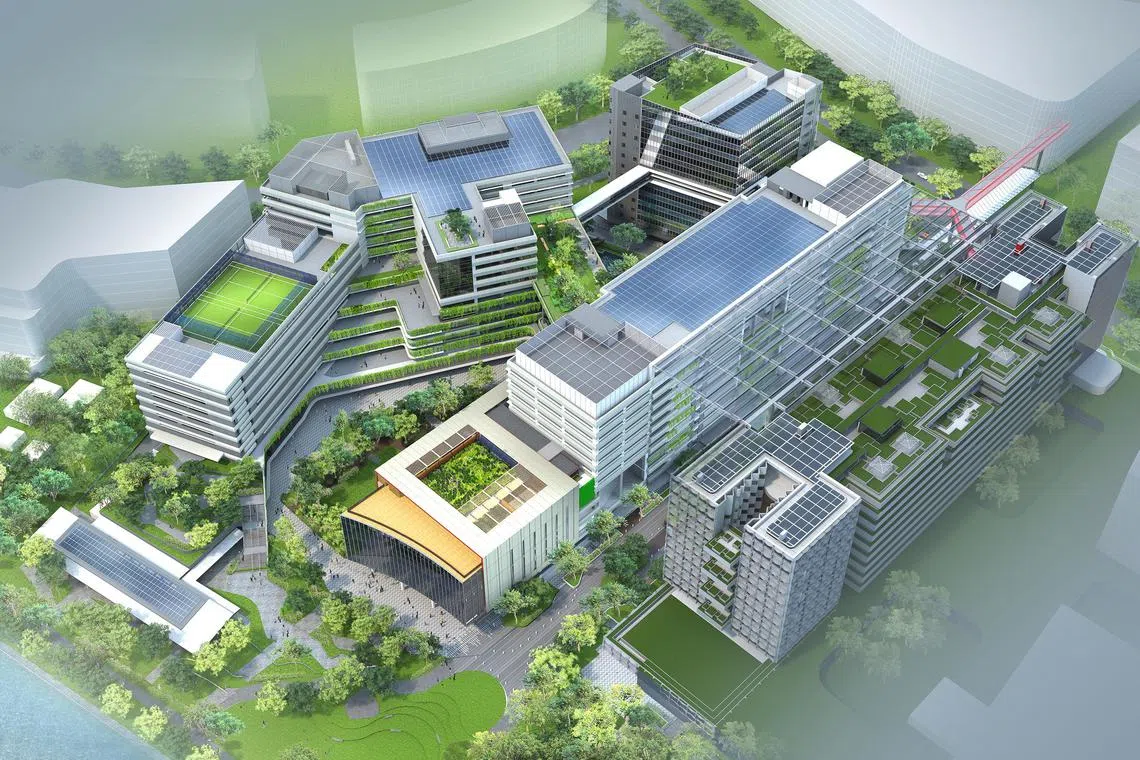SIT to be ‘part and parcel’ of Punggol, to engage students, residents and businesses there
Sign up now: Get ST's newsletters delivered to your inbox

Some 3,800 students will start classes in one part of the completed 91,000 sq m campus in September.
PHOTO: SINGAPORE INSTITUTE OF TECHNOLOGY
Follow topic:
SINGAPORE – On Aug 24, Singapore’s fifth university, the Singapore Institute of Technology (SIT), will mark a new chapter in its history, with a walk to celebrate the phased move to its campus in Punggol.
Some 3,800 students will start classes
He said the university had planned for its campus, which is served by Punggol Coast MRT station and Teck Lee LRT station, to be “porous”, allowing the public access to some of its ground-floor spaces and to attend its events.
Students and faculty have also planned several programmes to serve the residents and businesses in the area. One key scheme is a science, technology, engineering and mathematics (Stem) outreach programme for secondary school students in Punggol.
And so far, students from Edgefield, Greendale, Punggol, and Yusof Ishak secondary schools have already taken part in an annual competition held to promote innovation.
SIT will expand its scope of engagement with these four schools to engage 5,000 students over the next five years through regular activities, including talks, workshops, industry visits, mentorship, and an annual camp.
Professor Chua said more than 200 SIT students, who are former students of the four secondary schools, have been identified as potential volunteers for the outreach programme.
Under the plan, they will head back to their alma maters to give talks and coach the students there on innovation projects, with the hope that the young learners will be inspired to pursue a university education in Stem and become future innovators.
Another Stem-related programme for secondary school students – a structured mentoring programme at the university’s makerspace – will be located near Punggol Coast MRT station and be ready by the end of 2025.
Explaining the importance of promoting Stem to students, Prof Chua said: “The demand for Stem professionals across various industries is outpacing the supply of local graduates. Given the country’s concerted efforts to ignite Stem interest among Singaporeans, particularly females, it’s natural that SIT, as a university with a strong focus on technology, actively participates in these initiatives.”
SIT also has plans to engage and serve the larger Punggol community. For businesses, there will be the Hatchery, a 10-storey building that is purpose-built to facilitate cross-fertilisation and incubation of ideas between academia and industry.
Prof Chua said the campus’ location in Punggol Digital District presents more opportunities to work with companies, as SIT makes a name for itself for its applied learning approach and close ties to industry.
“Our academic staff and students will be able to spend more time with the companies nearby to understand the latest technology trends, how they are riding these changes and what their needs are. This will also enable us to better position our education and research to meet their needs.”
For the general public, there are various community initiatives, including public talks, upskilling courses, volunteer opportunities and social innovation projects.
Echoing what Education Minister Chan Chun Sing said at the university’s topping-out ceremony in 2023, Prof Chua noted that SIT will strive to be not just an institute of higher learning, but also an institute of continuous learning – to become a focal point for adult learning.
As the university marks its 10th anniversary in 2024, it has also initiated “10 Acts for Good” to give back to the community, including mentorship programmes for at-risk youth and healthy food options for beneficiaries within the Punggol community.
Prof Chua also highlighted the setting up of a mangrove conservatory, which aims to preserve a wide range of genetically diverse mangrove species and reintroduce species that have disappeared from the local ecosystem.
He said: “All in, we want to create a campus atmosphere that encourages people to come together to share ideas, engage in personal growth, and build a culture of lifelong learning.”
Punggol resident Cameron Soh, 46, hopes his two polytechnic-going daughters will end up studying in SIT, which he admires for its close ties to industry.
The business development manager, who studied in a college town in the US, said: “The college towns are charming, renowned for their intellectual energy and stimulating environment. Just having a university there fosters a culture of learning, sharing and open discussions.
“I hope SIT does that for Punggol.”



